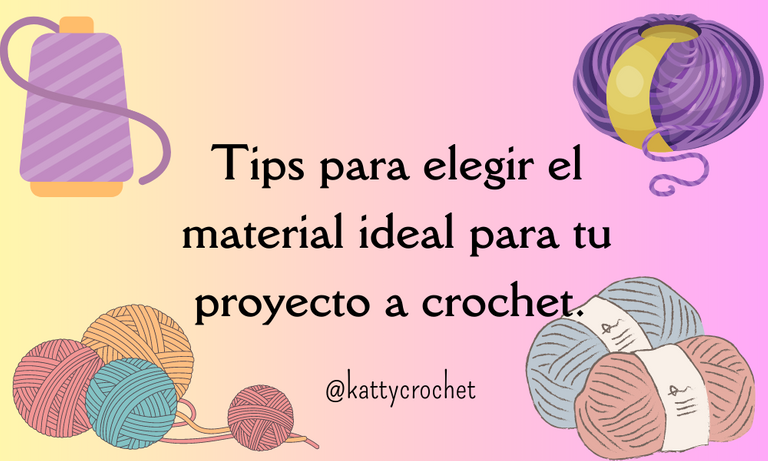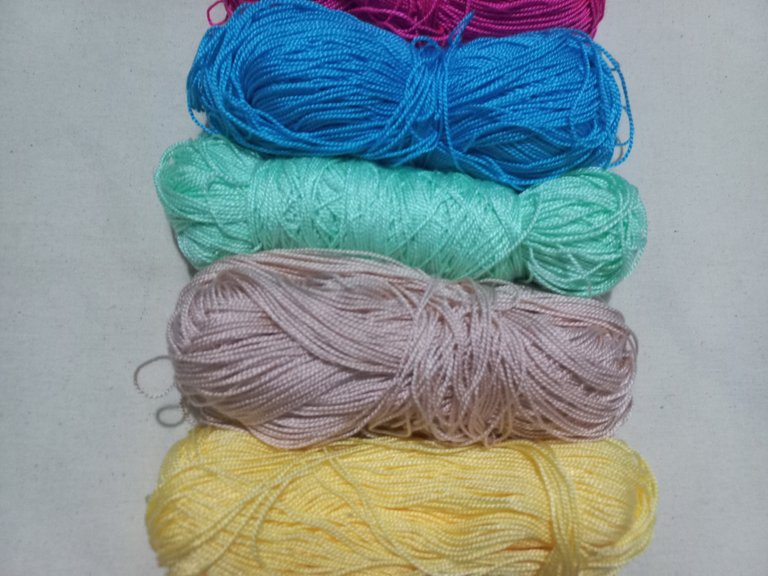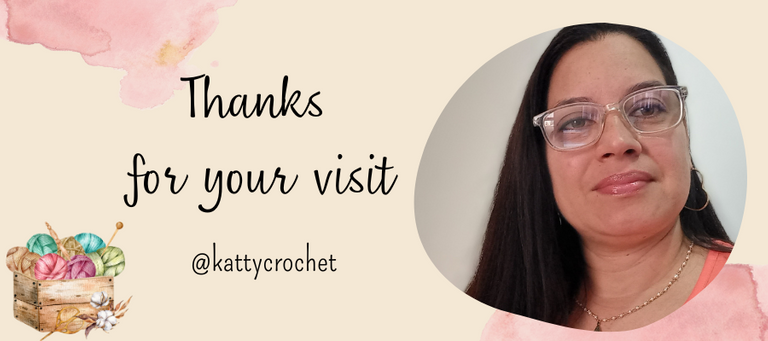MWM|| Tips para elegir el material ideal para tu proyecto a crochet. 🧶🧵


Blessed day my dear and appreciated NeedleWorkMonday colleagues. In today's post I want to share with you some tips, that according to my experience, are important to take into account when buying the right material to make our crochet project.


ELEGIR EL PROYECTO, PATRÓN O DISEÑO
Cuando estuve en Perú tuve la gran oportunidad de visitar lugares donde vendían todo tipo de materiales para tejer y bordar. Les confieso que fue muy impactante ver la gran variedad de lanas, hilos y estambres, de distintos colores, formas y texturas.
El error que cometí muchas veces era comprar el material por su apariencia; compraba todo lo que me parecía bonito. Luego, cuando me disponía a tejer era difícil hallar un proyecto para cada material. Muchas veces no tenía idea del nombre o la composición del material, algunas veces lograba ejecutar un proyecto, pero la mayoría de las veces, el ovillo se quedaba guardado sin saber qué hacer con él.
Lo mejor que podemos hacer para no perder tiempo ni dinero es salir a comprar el material una vez que tengamos claro lo que queremos tejer. Esto nos facilitará a elección del material adecuado.
Por ejemplo, si queremos tejer ropa para bebé, ya sabemos que el material debe cumplir con ciertas características, como la suavidad, que sea antialérgico, que sea liviano, preferiblemente de fibras naturales como el algodón y por lo general, se usan colores pasteles.
Por otro lado, si vamos a tejer ropa de invierno, el material tiene unas características diferentes al material para tejer ropa de verano y así por el estilo.
En resumen, el proyecto determina el tipo de material.
CHOOSE THE PROJECT, PATTERN OR DESIGN
The first and most important thing is to be clear about the project to be carried out. When I was in Peru I had the great opportunity to visit places where they sold all kinds of materials for knitting and embroidery. I confess that it was very impressive to see the great variety of wool, yarns and stamens, of different colors, shapes and textures.
The mistake I often made was to buy the material by its appearance; I bought everything that looked pretty. Then, when I set out to knit it was difficult to find a project for each material. Many times I had no idea of the name or composition of the material, sometimes I was able to execute a project, but most of the time, the ball of yarn was put away and I didn't know what to do with it.
The best thing we can do to avoid wasting time and money is to go out and buy the material once we are clear about what we want to knit. This will make it easier to choose the right material.
For example, if we want to knit baby clothes, we already know that the material must meet certain characteristics, such as softness, anti-allergic, light, preferably made of natural fibers such as cotton, and usually pastel colors are used. On the other hand, if we are going to knit winter clothes, the material has different characteristics than the material for knitting summer clothes and so on.In short, the project determines the type of material.

COMPRAR LA CANTIDAD NECESARIA
Elegir la puntada también es clave para saber la cantidad de material, ya que algunas puntadas suelen ocupar mucho más hilo que otras.
Comprar el material suficiente en una misma compra es fundamental, ya que los hilos vienen por lotes y por tonos. Un mismo color puede variar un poco en tono si provienen de lotes diferentes. Para este punto, siempre recomiendo guardar la etiqueta del ovillo con un pedacito de hilo, para que sea mucho más fácil encontrar el mismo material en una siguiente oportunidad y así evitar que el proyecto quede con tonos disparejos.
BUY THE NECESSARY AMOUNT
At this point it is also key to be precise about the type of project to be carried out. For large projects it is important to buy an additional ball of yarn to the calculated amount. Some people usually make a small sample of 10 x 10 cm with the stitch they will use in their project to calculate the amount of material needed for the final size of the project.
Choosing the stitch is also key to knowing the amount of material, as some stitches tend to take up much more thread than others.
Buying enough material in the same purchase is fundamental, since threads come in batches and shades. The same color can vary a little in tone if they come from different lots.
For this point, I always recommend keeping the yarn ball label with a small piece of yarn, so that it will be much easier to find the same material at the next opportunity and thus avoid the project being left with uneven tones.

CONOCER LAS FIBRAS
Las fibras sintéticas tienen mucho más brillo, aportan elasticidad y textura al tejido y suelen ser mucho más económicas. Un ejemplo de ellas son el nylon, el poliéster y los hilos acrílicos.
Las fibras naturales suelen ser mucho más ligeras, y más suaves. Entre las fibras naturales provenientes de plantas encontramos el algodón y el bambú. Estos materiales suelen ser más opacos que las fibras sintéticas, a excepción del algodón mercerizado o satinado.
Entre las fibras naturales provenientes de animales se encuentran la lana de oveja, lana de alpaca, lana de cabra cachemira entre otros. Estas lanas son ideales para proyectos y prendas de invierno. He tenido la oportunidad de hacer prendas con lana de alpaca y me pareció un material excelente porque a pesar de ser muy ligero es muy calentito y protege bastante del frío.
TO KNOW THE FIBERS
A very important and at the same time interesting aspect, that we are learning with experience, is to know how to identify fibers. There are two types of fibers: synthetic fibers, which are made from petroleum products, and natural fibers, which can come from plants or animals.
Synthetic fibers have much more luster, provide elasticity and texture to the fabric and are usually much cheaper. Examples are nylon, polyester and acrylic yarns.
Natural fibers are usually much lighter and softer. Natural fibers from plants include cotton and bamboo. These materials are usually more opaque than synthetic fibers, with the exception of mercerized or satin cotton.
Natural fibers from animals include sheep wool, alpaca wool, goat wool, cashmere wool and others. These wools are ideal for winter projects and garments. I have had the opportunity to make garments with alpaca wool and I found it to be an excellent material because despite being very light it is very warm and protects from the cold.

ELCALIBRE O GROSOR
Por otro lado, algunos proyectos es mejor tejerlos con hilos más gruesos y esponjosos, como es el caso de proyectos grandes como mantas, cubrecamas, cojines, bolsos, entre otros. Una vez más, el calibre del material dependerá del tipo de proyecto.
Hace un tiempo decidí tejer un bolso de compras con un material de algodón crudo de 4 mm, elegí este material porque quería un bolso muy resistente; sin embargo, el bolso por sí solo pesaba casi 2 kg debido al grosor del material, lo que no resultaba ser práctico, entonces comprendí que había fallado en la elección del material. Para este tipo de proyecto el material ideal es el nylon de 2mm.
THE SIZE OR THICKNESS
The thickness of the thread for me is essential. There are projects that require very thin materials so that they look much more delicate and are very light, as in the case of some garments, such as baby dresses, table linens, and jewelry.
On the other hand, some projects are best knitted with thicker and fluffier yarns, as in the case of large projects such as blankets, bedspreads, cushions, bags, among others. Again, the gauge of the material will depend on the type of project.
Some time ago I decided to knit a shopping bag with a 4 mm raw cotton material, I chose this material because I wanted a very resistant bag; however, the bag by itself weighed almost 2 kg due to the thickness of the material, which was not practical, then I realized that I had failed in the choice of material. For this type of project the ideal material is 2mm nylon.

EL PRECIO ES UN FACTOR IMPORTANTE
Por lo general, los materiales de fibras naturales son más costosos, pero también nos ofrecen beneficios considerables. Para hacer proyectos de cocina, como agarraderas, tapetes o posa vasos, yo prefiero comprar materiales económicos porque son piezas que se le da mucho uso y se desgastan más rápido, pero como el material es más barato se pueden reemplazar cada cierto tiempo.
THE PRICE IS AN IMPORTANT FACTOR
Evaluating the price of the material is also important when buying. If we are going to make a project for sale, it is best to choose a good quality material that guarantees durability over time, so that there is a good price-value relationship at the time of charging for the piece.
In general, natural fiber materials are more expensive, but they also offer considerable benefits. For kitchen projects, such as potholders, place mats or cup holders, I prefer to buy inexpensive materials because they are pieces that get a lot of use and wear out faster, but since the material is cheaper, they can be replaced from time to time.

¿CUÁLES MATERIALES DEBES EVITAR SI ERES PRINCIPIANTE?
Sobre este tema hay mucho hilo que cortar, pero la publicación ya se está haciendo muy larga, así que les dejo, deseándoles un lindo fin de semana.
Gracias por leer, saludos y bendiciones.
WHICH MATERIALS SHOULD YOU AVOID IF YOU ARE A BEGINNER?
If you are new to crochet and are just learning the technique, there are some materials that are best avoided. If you want to know what these materials are, I'll be telling you about them in a future post.
On this topic there is a lot of thread to cut, but this post is getting too long, so I'll leave you, wishing you a nice weekend. Thanks for reading, greetings and blessings.


Todas las fotos fueron tomadas con mi celular Samsung A32.
El banner de portada y los separadores de textos son diseñados por mi en Canva.com
Uso traductor Deepl

Fíjate, pues, todo lo que hay que tomar en cuenta para comprar materiales para un proyecto determinado. Muy buenas tus recomendaciones, amiga. Todos los días se puede aprender algo nuevo. Saludos, un abrazo.
Totalmente cierto, todos los días aprendemos cosas nuevas e interesantes. Seguimos aprendiendo. Gracias por leer. Muchos saludos!
Wow, que post tan acertado, estoy comenzando con mi emprendimiento de crochet y saber todas estas cosas, me servirá de mucha ayuda sin duda alguna, muchísimas Gracias por compartir, estaré atenta para el próximo post ✨❤️
Gracias por tomarte el tiempo para leer este artículo. Me agrada que te haya parecido interesante.
Gracias @kattycrochet por compartir esos buenos consejos, muy útiles cuando vamos a hacer los proyectos. Saludos.
Gracias a ti por leer. Saludos 🤗
Excelentes tips para comenzar a tejer.